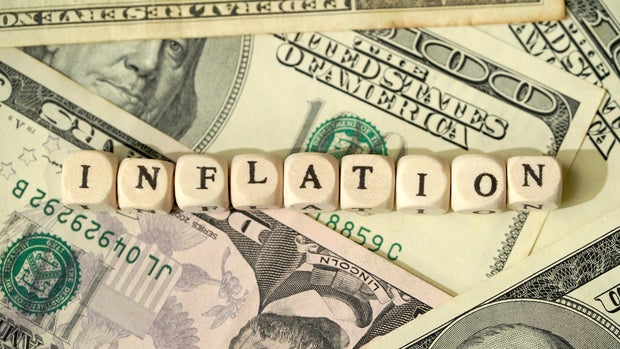Getty Images
The latest inflation reading likely caused a collective sigh of relief among economists and consumers alike. According to the data, released today, the July Consumer Price Index rose just 2.7% annually, slightly below the 2.8% that experts had predicted. And, when you factor in the other metrics, like core inflation sitting at 3.1% and month-over-month increases remaining modest at 0.2%, this latest reading could indicate that the economy has found some stability, even as concerns about tariff impacts and food price pressures persist.
For the millions of Americans drowning in credit card debt, this steady inflationary environment might also seem like a reason to breathe easier and potentially reconsider any drastic debt relief measures they were weighing. After all, if prices aren’t spiraling out of control and there’s still a high chance of Federal Reserve rate cuts in September, perhaps the financial pressure will ease naturally. As a result, some might even wonder if holding onto debt and hoping for better economic conditions makes more sense than pursuing aggressive debt forgiveness strategies.
But here’s the reality that steady inflation doesn’t change: While overall prices may be stabilizing, credit card interest rates remain punishingly high, and the gap between what your money loses to inflation and what you’re paying in credit card interest remains enormous. So is debt forgiveness still worth pursuing right now, or should those with high-rate credit card debt look for other avenues to get rid of their debt instead?
Find out how you can start the debt forgiveness process today.
Does debt settlement still make sense with inflation holding steady?
While steady inflation is undoubtedly good news for the broader economy, it doesn’t fundamentally change the equation for Americans trapped in high-rate debt cycles. The current environment may actually strengthen the case for debt forgiveness. Here’s why:
Credit card rates remain at historic highs despite steady inflation
The most compelling reason debt settlement remains relevant has nothing to do with inflation and everything to do with interest rates. Despite the Federal Reserve hinting at future rate cuts, credit card companies continue charging average rates near 22%, and often charge much higher rates to borrowers with less-than-perfect credit. This means that if you’re carrying a $10,000 balance, you’re potentially paying hundreds or thousands of dollars just in interest charges alone each year, assuming you make only minimum payments.
Compare that to the 2.7% inflation rate, and you can see the stark disconnect. While your dollars are losing purchasing power at under 3% per year, your credit card debt is growing at a rate seven times faster. Steady inflation doesn’t make these crushing interest rates any more manageable. It just means you’re not getting hit with a combination of rising prices and rising debt service costs simultaneously.
Explore your debt relief options and find the right strategy here.
Economic uncertainty still looms despite stable prices
While the latest inflation reading was encouraging, economic headwinds remain significant. The impact of new tariffs is still working its way through the system, for example, with experts predicting more pronounced effects in late 2025 and early 2026. And, food costs continue rising, with essentials like coffee up significantly year over year. For many households, these pressures mean that even steady overall inflation feels anything but stable when it comes to daily expenses.
This ongoing uncertainty makes carrying high-rate debt even riskier. If economic conditions deteriorate or if tariff-induced price increases accelerate as some economists predict, having thousands of dollars in credit card debt will only compound financial stress. But debt forgiveness allows you to eliminate or dramatically reduce these obligations while economic conditions remain relatively stable, rather than gambling on future improvements that may never materialize.
The opportunity cost of waiting remains enormous
Perhaps most importantly, steady inflation doesn’t change the fundamental opportunity cost of carrying high-rate debt. Every month that you continue paying 22% interest (or more) on your credit card balances is taking up money that could go toward emergency savings, retirement contributions or other wealth-building activities. And, with inflation at manageable levels, this is an ideal time to tackle debt aggressively because you’re not simultaneously fighting rapidly rising living costs.
Even in a low-inflation environment, the average American needs substantial emergency savings to weather unexpected expenses like medical bills or job loss. If you’re dedicating hundreds or thousands of dollars monthly to credit card payments, you’re preventing yourself from building this crucial financial cushion. Debt forgiveness can free up that cash flow, allowing you to focus on financial stability rather than just treading water with minimum payments.
The bottom line
Steady inflation is certainly welcome news for Americans, but it doesn’t make crushing credit card debt any less crushing. With interest rates near 22% and economic uncertainties still on the horizon, debt forgiveness remains a viable and often necessary option for those struggling with substantial credit card balances.
And, the current environment may actually be optimal for pursuing this type of debt relief. Inflation isn’t adding extra pressure to household budgets, potential Fed rate cuts could improve negotiating positions with creditors and economic stability provides a clearer path forward. So, rather than viewing steady inflation as a reason to delay debt relief, consider it an opportunity to tackle high-rate obligations while other financial pressures remain manageable.



